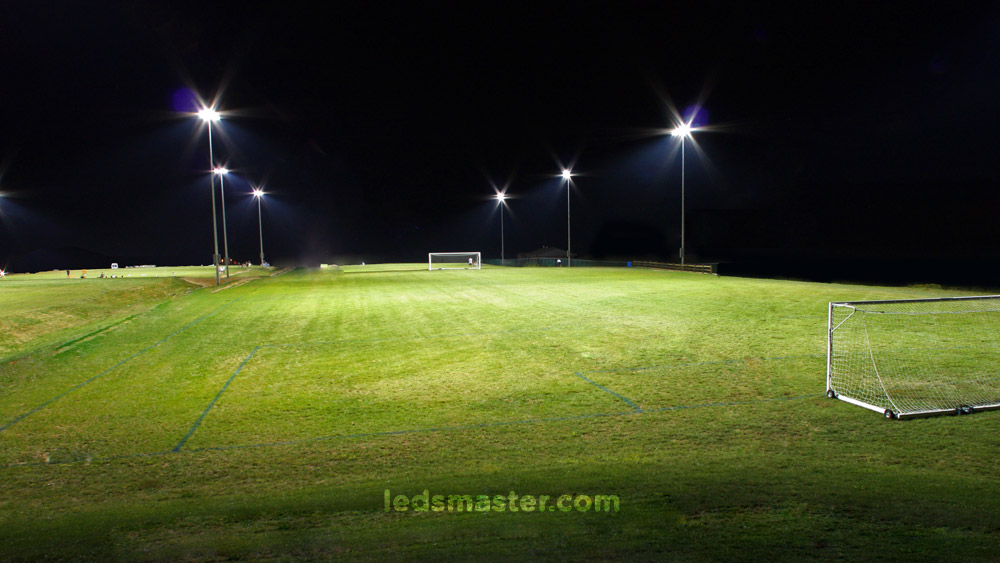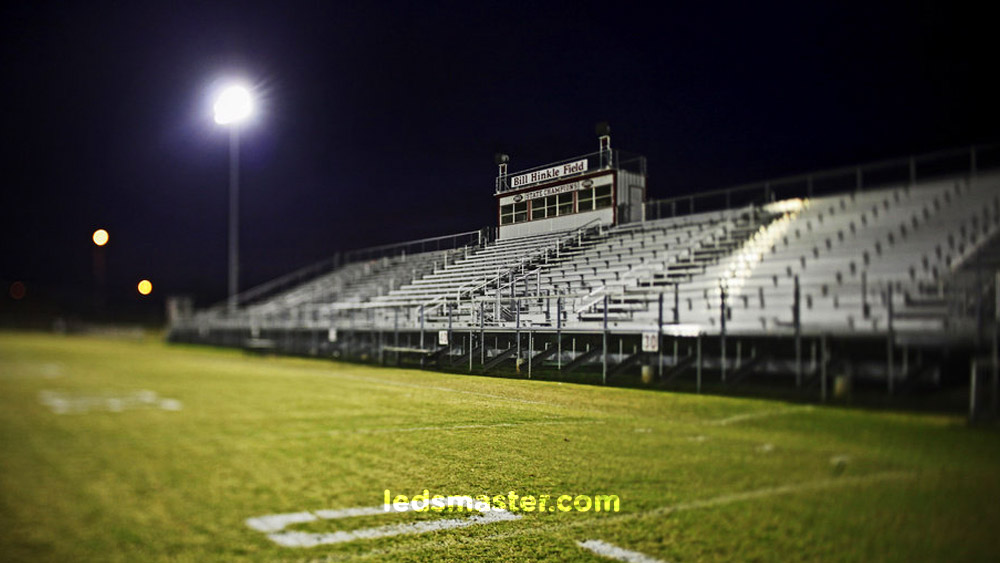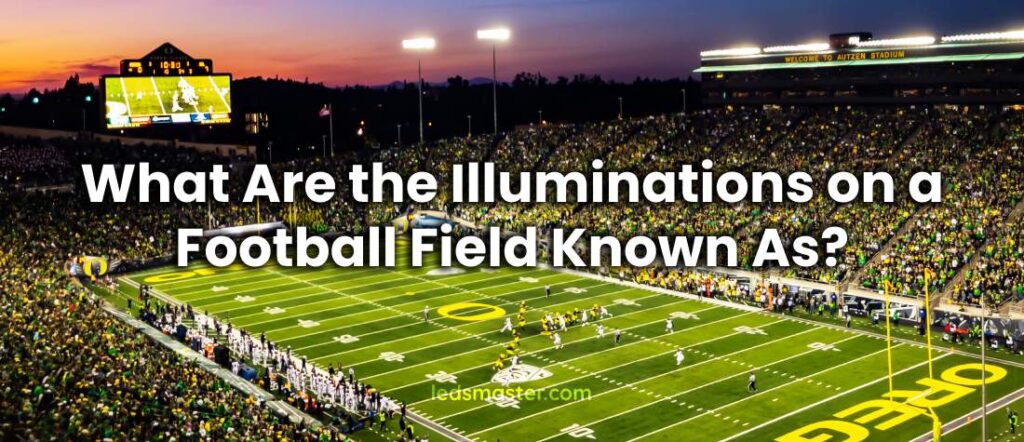Table of Contents
ToggleIntroduction
When planning the lighting for a football field, it’s essential to research the various lighting options available for stadiums. However, what exactly are the lights on a football field called? There are numerous terms associated with stadium lighting, including football field lights, football pitch floodlights, stadium floodlights, high mast lights, and more. Given this array of terminology, we’ll compile a comprehensive list of the names used for football field lights to ensure accurate reference. Additionally, we’ll explore different types of football field lights to make informed decisions when selecting lighting fixtures.
| How to call the lights on football field | Meaning |
| Flood lights | A general name of lighting fixtures that provide broad beam illumination. The lights can usually give out high intensity light beam to light up the broad area such as football fields. |
| Sport lights | Another type of lighting. Compared to floodlights, spot lights usually have a smaller beam angle, so it can illuminate the far distance of the football stadium. |
| High mast lights | As it name suggested, we can call football field lights as high mast lights as they are sometimes mounted to the tall poles with the height of 10 to 20 meters. |
| Football field LED lights | LED is an energy-saving light source. Many football field owners tend to replace their HID lights to LED because LED has higher life span and energy efficiency. |
| Metal halide football stadium lights | A conventional lighting for football field, which is applied for more than 40 years. It is occasionally eliminated nowadays because of its long warm up time. |
| Football stadium lighting | Compared to football field lighting, the stadium lights have a higher intensity and better optics. We will use stadium lights if the football field has demanding lumen requirement such as FIFA or Olympic Games, with > 1000 lux horizontal and vertical illuminance requirement |
Why are football field lights referred to as floodlights?

As the name implies, floodlights emit a wide, expansive beam of artificial light. These lights effectively “flood” the surface of the football field, hence their common designation as football field floodlights. When visiting public parks or recreational football fields, you’ll likely encounter bright lighting fixtures mounted on light poles. While similar in appearance to those on football fields, they may differ in power, lumens, and beam angles.
Applications of football field floodlights
Floodlights are incredibly versatile lighting fixtures suitable for various sports facilities and expansive areas. With power ranging from 100W to 10,000W, they provide ample illumination across different settings. Examples of places where floodlights are commonly employed include football fields, soccer pitches, stadiums, baseball fields, golf courses, cricket fields, and tennis courts. Their adaptability to diverse environments makes floodlights indispensable for lighting solutions in different areas.
Why are stadium lights referred to as spotlights?
Stadium lights are sometimes labeled as spotlights when the light poles are exceptionally tall, typically exceeding 40 meters. This designation arises from the necessity for concentrated illumination over long distances, such as the goal line and corners of the field. A spotlight typically features a narrow beam angle ranging from less than 20 to 45 degrees. To achieve optimal lighting design for football stadiums, a combination of floodlights and spotlights on the same pole is often employed.
Floodlight vs spot light on football field
| Flood lights | Spot lights |
| Larger beam angle (> 90 to 120 degrees) | Smaller beam angle (< 30 to 45 degress) |
| Light up the close distance | Light up the far distance |
| Light up the broad area | Light up the narrow area |
| Lower glare | Higher glare |
Upgrading Football Field Floodlights

Lighting overhauls for football stadiums
Upon examining the table at the outset of this article, one will notice a type of football field light known as metal halide. Increasingly, football field owners are transitioning to LED football pitch floodlights due to the numerous advantages they offer.
Energy Efficiency
Our 800W LED football field floodlights represent a significant leap in energy efficiency, capable of seamlessly replacing metal halide lights with power consumption ranging from 2000W to 3000W. This replacement translates into substantial energy savings, typically ranging from 70% to 90%. The remarkable efficiency of LEDs stems from their innovative design, which relies on semiconductor technology to generate visible light, contrasting with the traditional method of producing light through direct heat. This fundamental difference in operation not only results in reduced energy consumption but also enhances the longevity and reliability of the lighting system. Thus, the transition to LED lighting not only contributes to environmental sustainability but also presents a compelling cost-saving opportunity for football fields, offering long-term benefits for both operators and the broader community.
Reduced Light Pollution
Incorporating anti-glare optics into LED lights represents a proactive measure to combat light pollution, ensuring that the illumination remains focused on the intended area without causing unnecessary dispersion or discomfort to surrounding environments. This strategic implementation not only helps to preserve the natural ambiance of the surroundings but also minimizes potential disturbances to nearby residents or wildlife habitats.
Furthermore, the advanced technology utilized in LED stadium lighting systems goes beyond mere illumination. By minimizing flickering, these cutting-edge fixtures provide a steady and consistent light source, enhancing the overall visual experience for everyone involved in the football event – from players on the field to spectators in the stands, and even camera operators capturing the action. The absence of flicker ensures smoother motion perception, sharper imagery, and reduced eye strain, thereby elevating the quality of the viewing experience and contributing to the overall enjoyment and engagement of the audience.
Instant On/Off Functionality
The immediacy of LED stadium lights contrasts starkly with the delayed onset of brightness associated with metal halide lights. Whereas traditional metal halide fixtures often necessitate a wait of 15 to 20 minutes to achieve full illumination, LED lights provide instantaneous brightness upon activation. This rapid response time ensures a seamless experience for spectators, eliminating any prolonged waiting periods before the commencement of football matches.
The immediate illumination offered by LED stadium lights not only enhances the convenience and efficiency of event operations but also contributes to the overall enjoyment of the spectator experience. With no delay in lighting, spectators can enter the stadium and immediately immerse themselves in the excitement of the game without being subjected to dimly lit or partially illuminated conditions. This instant brightness creates a welcoming and engaging atmosphere from the moment spectators arrive, setting the stage for an unforgettable football experience.
Smart Control Capabilities
LED stadium lights offer compatibility with advanced smart lighting systems, integrating seamlessly with DMX (Digital Multiplex) technology. This feature enables precise control over the intensity of each individual fixture through a dedicated panel or computer interface. Such fine-grained control empowers stadium operators and lighting technicians to tailor the lighting environment to meet specific requirements and preferences.
The versatility afforded by smart lighting systems goes beyond basic on/off functionality. With DMX-enabled LED stadium lights, operators can dynamically adjust light intensity, color temperature, and even create intricate lighting effects with ease. Whether it’s enhancing visibility during gameplay, creating dramatic lighting effects for halftime shows, or adjusting lighting levels to accommodate broadcast requirements, the flexibility of DMX-controlled LED lighting allows for unparalleled customization and creativity.
Moreover, the ability to remotely monitor and adjust lighting parameters offers operational efficiencies and cost savings. Stadium personnel can optimize energy usage by dimming or turning off lights in unoccupied areas, reducing electricity consumption and minimizing environmental impact. Additionally, the precise control provided by smart lighting systems ensures consistent and uniform illumination throughout the stadium, enhancing visibility for both players and spectators while minimizing glare and light spillage.
Enhanced Durability
The decision to replace traditional stadium lights with LED fixtures goes beyond just energy efficiency; it also presents a compelling case for long-term cost savings and environmental sustainability. LED lights are renowned for their exceptional longevity, boasting significantly longer lifespans compared to metal halide lights. With an average operational lifespan ranging from 20 to 35 years when used for 8 hours per day, LEDs offer a prolonged service life that minimizes the frequency of replacements and associated maintenance tasks.
This extended lifespan translates directly into substantial cost savings for stadium operators. By reducing the need for frequent bulb replacements and maintenance interventions, LED fixtures significantly lower ongoing operational expenses over the lifespan of the lighting system. Moreover, the durability and robustness of LED technology minimize the risk of unexpected failures or malfunctions, further reducing the likelihood of costly downtime and emergency repairs.
Beyond the immediate financial benefits, the adoption of LED stadium lighting also delivers significant environmental advantages. The longevity of LED fixtures means fewer resources are consumed in manufacturing, transportation, and disposal, resulting in reduced waste and carbon emissions over time. Additionally, the energy efficiency inherent to LED technology reduces overall electricity consumption, contributing to lower greenhouse gas emissions and mitigating the environmental impact associated with stadium operations.
Conclusion
The transition to LED stadium lighting represents a significant advancement in football field illumination, offering numerous benefits such as energy efficiency, reduced maintenance costs, and enhanced durability. LED lights not only contribute to minimizing light pollution but also improve the overall spectator experience through features like instant on/off functionality and smart control capabilities. By embracing LED fixtures, football field owners can achieve substantial cost savings over the long term while demonstrating their commitment to environmental sustainability. The versatility, efficiency, and reliability of LED stadium lighting make it a compelling choice for illuminating football fields and other sports facilities, ensuring that spectators, players, and organizers alike can enjoy the game under optimal lighting conditions for years to come.

